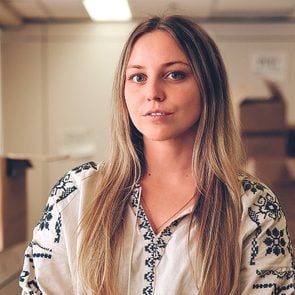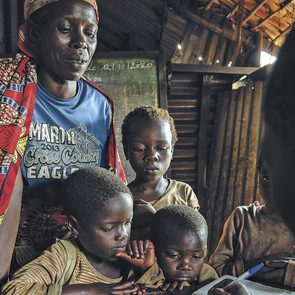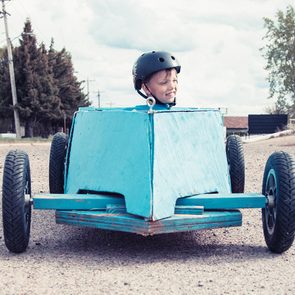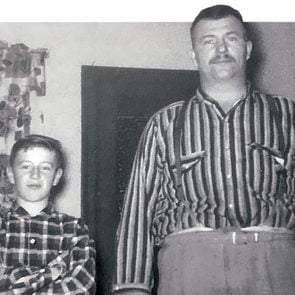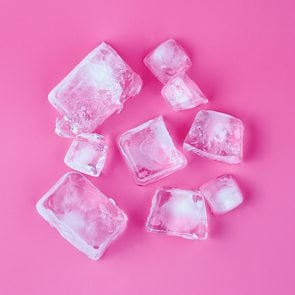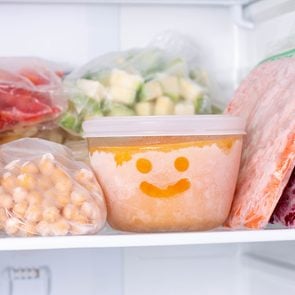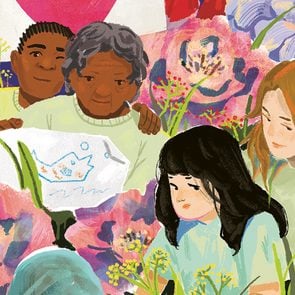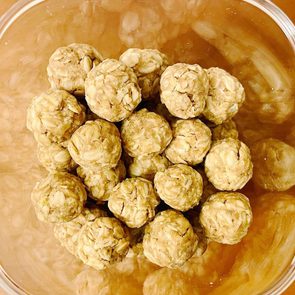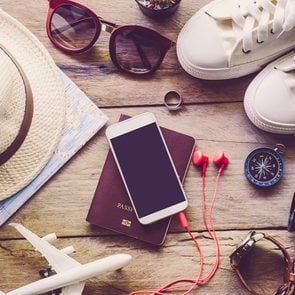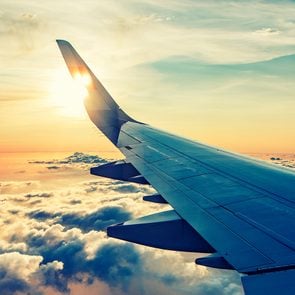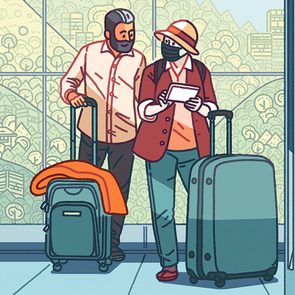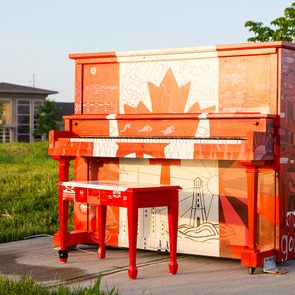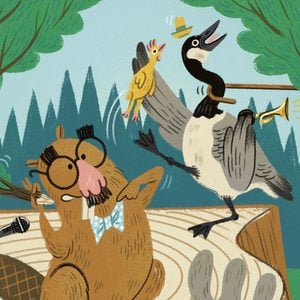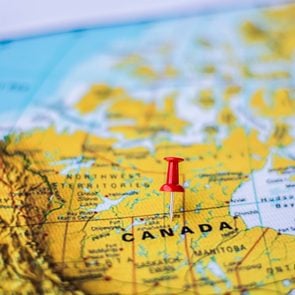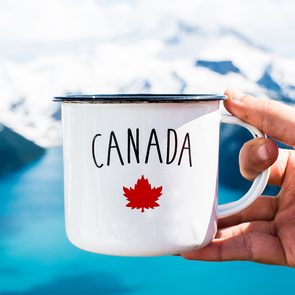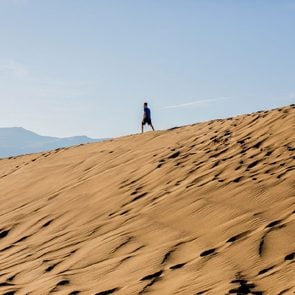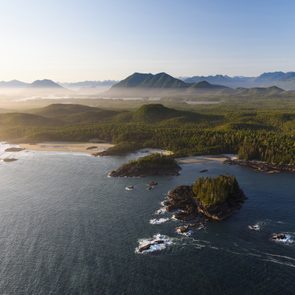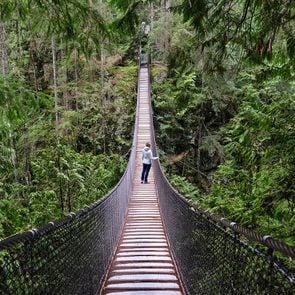If you feel like you and your partner have fallen into a rut with your sex life, your timing might be to blame. While we’d never tell you not to get busy if you’re both in the mood, there’s compelling evidence that you might want to rethink your sex schedule. The most popular time for love-making also happens to be the worst time.
A study in Frontiers in Psychology shows that the timing of men’s and women’s libidos are at polar opposites: Women feel the most desire in the evening, while men are most aroused in the morning. In the case of most straight couples, it looks like the woman might be getting the final say. The study found that the average couple is most likely to have sex between 9 p.m. and midnight—in other words, bedtime. But experts say that pre-sleep sex isn’t necessarily ideal.
Having a romp while you’re already between the sheets is undeniably convenient, but there’s a downside to saving sex for lights-out time, says “The Sleep Doctor” Michael Breus, PhD, author of The Power of When. “Sex at bedtime is not bad; it’s just that most people are exhausted,” he says. When your body is begging for shut-eye, there’s a good chance you won’t have the energy for the most mind-blowing encounter, he says.
Depending on the person, nighttime sex can also rev you up, making you bright-eyed and bushy-tailed right before trying to sleep, adds Lisa Thomas, LCSW, LMFT, DAACS, licensed relationship and sex therapist. But for other couples, it might have the opposite effect. “For the majority of people, sex is a tension reducer and relaxer,” she says. “People have sex before sleep to help them fall asleep.”
Both Dr. Breus and Thomas agree that sleeping together after you’re done, well, actually sleeping could make for better quality sex. While you’re resting at night, your body is at work building up hormones, and you’ll also wake up with more energy and creativity for satisfying sex, Dr. Breus explains. “You now have a prescription for morning sex,” he says.
Morning sex might not be ideal for couples with early or mismatched schedules, so Thomas recommends getting creative with sex timing. Try meeting at home for some mid-afternoon frisky time, or get busy when you’d normally be watching Netflix. “Any way couples can figure out how to make it fun and be in connection is great,” she says. “Couples that use sex to unwind and connect and reduce stress and tension are the ones who have sex over their lifetime.”
Now that you know the worst time of day to have sex, find out 13 sexual health tips your urologist wants you to know.
On a July day in 2021, Nasrat Khalid was on the phone to his native Afghanistan when he got some awful news: “This whole city has turned into a refugee camp,” Kabulbased Mohammed Nasir told him, signalling a full-blown humanitarian crisis.
Nasir is the chief of operations for Khalid’s company, Aseel, which positions itself as the Etsy of Afghanistan. It allows artisans making things like blankets and jewellery to sell their products around the world via its app and website. Artisans may also receive training in handicrafts and business practices.
Khalid, who is based in Washington, D.C., worried constantly about Kabul that summer as U.S. forces withdrew from Afghanistan and city after city fell to the Taliban. His Afghan-based team struggled to ship products to buyers, while local artisans saw their incomes dry up. Plus, many of them were fleeing the increasingly dangerous provinces.
Khalid knew he had to help his people. He used some of the company’s savings to buy food, and Nasir delivered it to a refugee camp in Kabul. Hungry people attacked the truck, tearing Nasir’s clothes in their desperation.
It was clear that they needed to take a more systematic approach. Every aid recipient got an identification number, and Aseel’s tech infrastructure tracked every drop-off. “We created a whole new distribution system,” says Khalid.
An emergency-response page was added to the company’s website, allowing donors to give money or buy emergency packages of food or supplies. They can even select a special recipient, so that expat Afghans can send money and aid to family members.
Later, Khalid created a GoFundMe-style page on Aseel’s website that allows people to run fundraising campaigns for, say, giving food to people in a particular province or funding a vocational program for girls. As of early 2023, Aseel had raised more than US$750,000 from donors and helped some half a million people, in part through a partnership with the U.S.-based Women for Afghan Women.
Recipients include Fatima, a single mother in Kabul who lives with 12 people in a one-room house. “Aseel’s food packages helped me survive the worst days of my life,” she told Reader’s Digest through a translator.
Before she and her sister received Aseel’s packages, they had been going without enough food in order to provide for their kids and send them to school. “I remember the first day I received a food package. My kids played music and danced for the whole day.” Fatima joined an Aseel apprenticeship program; after she completes it, she will be able to find employment with a local handicraft company.
In November 2022, the Society for International Development gave Khalid a leadership and innovation award. Jason Criss Howk, director of the U.S. advocacy group Global Friends of Afghanistan, lauds what Khalid has done with both the charitable functions of Aseel and its for-profit arm.
“Aseel has become a vital tool to get directed aid to certain places in the country,” he says. “They buy and distribute locally, which is sparking the economy.” He thinks Khalid could help people in other nations, too, while keeping overhead low—something large aid organizations struggle to do.
Next, Khalid would like to work more in Turkey’s Afghan refugee camps, and he has plans for further expansion and collaborations with aid groups.
“When Afghanistan collapsed, initially I felt very powerless,” says Khalid. “When my country went through this disaster, Aseel became a lifeline to people in need.”
If you enjoyed this story, check out this list of heartwarming and inspirational good news stories from around the world.
My son John loves school buses. He has been captivated by these bright yellow, wheeled marvels with their lights, levered doors, swing-out stop signs and back-up beepers ever since his older brother began attending school many moons ago. John’s grandfather (my dad), affectionately known as “Pépère,” decided to build John his own school bus for his 15th birthday. It was not intended to be just another gift that would be presented to John all wrapped up; when Pépère told John that together they would build him his very own bus, John was all smiles. John has Fragile X syndrome, and even more than school buses, he loves to be a good helper.

An old riding lawnmower served as the base for John’s bus. They removed the broken mower deck and repaired the tires. They then proceeded to build the body, using remnants of wood, plywood and tin from Pépère’s handyman projects, as well as bits and pieces from various sources such as an old mirror, a handle from an old tool, and scrap-metal bars. Other than the yellow paint, the stop sign and the lettering on the bus, this project was made entirely of recycled materials. The time spent together with his Pépère, along with John’s sense of accomplishment and pride of ownership, are priceless!

John loves to use his bus to run errands between home and Grandmama’s, and was happy to oblige when he was asked to lead his former elementary school in last year’s fall fair parade!
Next, check out the heartwarming story behind this car’s one-of-a-kind paint job.
It’s almost party time! Guests will start arriving soon, and you’re dashing around, putting the final touches on everything. All that’s left to do is tidy up your home bar. You hit the freezer to fill the ice bucket and… ugh! The ice cubes are stuck together in one giant clump. You either need to take the time to bust those frosty suckers apart or find really huge cocktail glasses.
Don’t put yourself in this situation again! While there are dozens of ways to break up ice cubes, it’s actually a cinch to keep them from sticking together in the first place. In fact, this secret has been around so long, your great-grandparents likely knew about it. What is this sub-zero strategy? It’s simple: store your ice cubes in a paper bag.

How to Keep Ice Cubes From Sticking Together
We’re talking about the sort of bag your mom used for school lunches or the type that the grocery store provides now that they’ve abolished plastic. Whether you rely on your ice dispenser, use an ice cube tray or buy it by the pound, quickly transfer the cubes to a clean paper bag. Fold it closed and store it in the freezer. Pull out the cubes as you need them. They shouldn’t stick together.
Why does this work? Some sources say the paper absorbs extra moisture, unlike plastic-bag counterparts. When excess moisture is minimized, there’s less chance of it freezing the cubes together.
If you’re making a lot of ice for a party, start filling the bag a week or two early. If you’re using the ice for adult beverages and mocktails at home, fill a smaller bag, and refill as needed. So stop chiselling blocks of ice, and quit ticking off your downstairs neighbours by banging bags of ice on the floor. Just grab a paper bag, fill it with cubes and let the party commence!
Now that you know how to keep ice cubes from sticking together, check out 20 summer drink recipes to cool you down on a scorching day.
Lies occur between friends, teachers and students, husbands and wives, lawyers and clients—yet nobody wants to be caught.
“I’ve interviewed crooks more apt to admit to a major crime than to lying,” says Glenn Woods, a criminal profiler, formerly with the RCMP, who’s been studying deceptive behaviour for more than a decade. “Everybody lies to some degree.”
Of course there’s a gulf that separates little white lies from the whoppers, but learning how to tell if someone is lying is a skill that’ll always come in handy. Here’s what to watch for.
How to Tell if Someone is Lying
Listen to the Voices
Pay attention to voice changes like change in pitch or cracking; they may well indicate deceit.
“A person’s voice pitch tends to be a bit higher when they’re lying than when they’re telling the truth,” says Dr. Mary Ann Campbell, director of the Centre for Criminal Justice Studies and an assistant professor of psychology at the University of New Brunswick in Saint John. “It doesn’t mean they’re lying for sure, but there’s a higher likelihood.”
Watch Those Words
What about written material? Can we spot misleading behaviour in letters, emails and even resumés?
Professor David Skillicorn and his students in the School of Computing at Queen’s University in Kingston, Ontario, created software—based on the deception model developed at the University of Texas at Austin—that can sniff out lies in emails and other written material by studying the frequency and kinds of words used. Skillicorn says liars tend to use fewer exclusive words such as but, or and except. They also tend to use more negative-emotion words such as ashamed, upset and embarrassed. “These are the words that send up red flags,” says Skillicorn. “It’s as though some part of the brain is feeling bad and this comes out in the writing.”
Look Past Shifty Eyes
While most people may interpret darting, unfocused eyes as a classic sign of lying, it’s vital to consider the context of the behaviour. For example, experienced poker players are careful not to make too much of eye “tells.” People usually look to the left or right when thinking about an answer. Someone not making eye contact should arouse suspicion, but eye contact, cautions Woods, can be a tricky evaluation tool: consider that a psychopath can look you in the eye and lie with ease. And in some cultures, it’s considered inappropriate to maintain eye contact.
Get Better at Body Language
Even though a high percentage of communication is thought to be non-verbal, no single part of the body—such as the eyes or hands—reveals the whole story when it comes to lying. Campbell says people who are lying often become more still: Hand gestures that normally accompany talking may occur with less frequency or intensity, and there may be fewer arm and leg movements. “The person becomes more focused on telling the lie,” explains Campbell, “so they get quieter in their body.”
Ask Questions—Quickly
If you suspect you’re being deceived, try this technique, which experts say can trip up a liar.
Try asking questions quickly—one after the other. “The initial lie is easy,” explains Kang Lee, professor at the Ontario Institute for Studies in Education’s Department of Applied Psychology and Human Development. “The follow-up lie is more difficult. When you continue to ask questions and put people on the spot, it gets harder to maintain the lie.”
Check for Emotional “Leaks”
Micro-expressions that flit across the face often expose a person’s real thoughts. “If you were to watch people on videotape, frame by frame, you would see them showing their true emotion just before they show the fake expression designed to cover up the lie,” says Campbell.
But these ultra-brief facial movements, some only lasting a quarter of a second, aren’t easy to spot. Even professionals trained in lie detection can’t always isolate them. And deliberate liars tend to add other expressions, like smiling, to disguise a lie.
So here’s hoping that the next time someone lobs a lie your way, you’ll know just how to catch it.
Now that you know how to tell if someone is lying, check out this expert advice on how to rebuild trust in a relationship.
Most dogs will eat just about anything—and if you have one, you know they’re particularly interested in anything their favourite humans are eating (as the wet nose nudging your elbow at the dinner table will eagerly remind you). But just because a dog wants to eat something doesn’t mean they should.
Obviously you can’t trust your pet’s judgment about their own diet, and getting educated about what your dog can and can’t eat is Pet Parenthood 101, says Efrem Hunter, DVM, MBA, a veterinarian and director of Veterinary and Scientific Affairs at Blue Buffalo.
Why it’s important to pay attention to your dog’s food
Who can resist those big eyes begging for just a nibble of whatever you’re having? You. It’s not easy, but it’s important.
Veterinarian Jacqueline Brister, DVM, a consultant for Embrace Pet Insurance, explains that it’s practical, too: “Feeding your dog only healthy foods saves on veterinary bills as some treatments for food toxicity can be very time consuming, involving round-the-clock care, and thus can be quite costly.”
Do dogs benefit from a varied diet?
Dog food made by a reputable company is scientifically designed to provide balanced and complete nutrition, and a dog can do quite well with that as their primary food, Dr. Hunter says.
There is no nutritional need to feed dogs extras, like fruit or veggies, but occasionally switching up a dog’s diet can have other perks, says Barbara Hodges, DVM, the director of advocacy and outreach for the Humane Society Veterinary Medical Association. This is one of the biggest points she brings up with clients: “I ask them to imagine if we ate the same thing every day all our lives,” says Dr. Hodges.
Not fun, right? Your four-legged friend might agree. “Variety really is the spice of life,” she says. “I don’t believe people tend to sit down and calculate the precise nutritional value of each meal. In general, we eat because we like the taste of things. Dogs are not different.”
How human food can hurt dogs
Certain foods can make our pets sick. “Not all human food agrees with our furry friends because they have different digestive systems, nutritional needs, and metabolisms,” Dr. Hunter says.
He adds that common offenders include lactose (the natural sugar in dairy products), fructose (the sugar in fruit), and simple carbs, like flour. While these might not seriously harm your pup, they can cause bloating, discomfort, and pain—especially when eaten frequently or in large amounts.
Next are the red-flag foods that can cause your dog to get sick or seriously ill. These foods contain compounds that might not be threats to us humans, but they can damage or destroy healthy cells in your pooch’s body. One lesser-known toxin for dogs is the apple seed, which contain cyanide, which can be poisonous.
All pet owners should know about the normal-for-people foods that are so toxic that even small amounts can cause death without treatment. These include grapes or raisins for some dog breeds, products that contain even the tiniest amounts of the sweetener xylitol (sometimes now referred to by other sneaky names such as “birch sugar”), and certain types of chocolate, Dr. Brister explains.
Beyond ingredients, there are a few other ways foods can create trouble for dogs. For instance, you may have noticed that your dog isn’t the best chewer when they’re excited—many dogs gulp or swallow food while little or no chewing. So while the food may not be toxic to dogs, it can pose a choking hazard.
Our experts explain that larger dogs tend to be able to digest more of, or safely swallow, some foods or parts of foods smaller dogs cannot. Some dogs have a naturally smaller or more narrow esophagus, which means they may have trouble swallowing the same food portions other dogs can safely eat.
Just as a few examples, this is true with hard or large table scraps, gristle, or bone. In some cases, dogs can choke on the seeds or stones of certain fruits, such as cherries, plums, peaches, nectarines, mangoes. Other foods may contain sharp parts (think spikes and stems) that can damage the throat or other parts of the digestive tract.
And know that even if your dog manages to completely swallow a bone, rind, or large pit without trouble, it can cause intestinal blockages which require immediate surgery, say our docs.
Foods dogs can safely eat
A majority of foods are safe for dogs in moderation and with proper preparation.
Ask your vet about a particular snack you might be curious about sharing with your dog. Generally safe human foods for dogs include:
- Strawberries, raspberries and blackberries
- Bananas
- Apples
- Melons, including watermelon and cantaloupe
- Pineapple
- Cucumber
- Mango
- Peaches, pears, plums, and nectarines
- Broccoli and cauliflower
- Brussels sprouts
- Carrots
- Green beans and peas
- Leafy greens
- Grains, cereals, and pulses (like chickpeas)
- Bread
- Mild cheeses
- Corn and popcorn (but do not let your dog get hold of a corn cob, as this can cause a serious blockage in their digestive system and possibly turn life-threatening)
- Peanut butter
- Honey
- Yogurt
Foods dogs cannot eat
Organizations such as the Humane Society of the United States provide lists of foods that are not safe for dogs to consume. Some of the most common foods that can be dangerous for dogs to eat, or that can contribute to health complications, include:
- Grapes, raisins, and currants
- Onion, leek, and chives
- Garlic and most other fresh and dried seasonings or spices
- Caffeine
- Chocolate
- Ice cream and milk
- Fruit and vegetable pits, husks, shells, stems, leaves, skins, cores, cobs, stones, pith, or peels
- Apple seeds and mustard seeds
- Candy
- Artificial sweeteners
- Gum
- Yeast dough
- Alcohol and hops
- Tomatoes
- Mushrooms
- Very sweet or salty foods
- Cherries
- Asparagus
- Raw potatoes
- Raw eggs, meat, poultry, fish, seafood, or animal bones
- Coconut flesh, oil, and water
- Jams and jellies
Tips for feeding dogs human foods
“As for any other foods added to a pet’s diet, the contribution should be kept below 10% of the calories,” says Jennifer A. Larsen, DVM, MS, PhD, a professor of clinical nutrition at the University of California-Davis Veterinary Medicine Teaching Hospital.
Snacks that are particularly high in fat or sugar should be minimized, even if they are healthy fruits and veggies. Dr. Larsen says you can check out the UC-Davis Veterinary Medicine Teaching Hospital’s website for more elaborate guidelines on feeding dogs treats and ideas for fun and exciting treats to feed your dog.
How to prepare fruits and vegetables for dogs
The experts say all fruits and vegetables should be well-washed and have their skins or peels, pits, cores, stones, pith, spikes, and other inedible parts removed before feeding them to a dog. Apples must also have their seeds and core removed to be safe for dogs to eat.
Most fruits and veggies are OK to serve to a dog raw, though some foods like pumpkin and potatoes must be cooked before a dog eats them. Our experts say that as a general rule, if you need to cook something before eating it yourself, it probably also needs to be properly cooked before it is safe for a dog to consume.
“It’s best to cut vegetables and hard fruits into small, bite-size pieces to avoid any choking hazards,” Dr. Brister adds. She says the size you cut up foods before feeding them to dogs should be relative to the dog’s size, meaning smaller dogs need to eat smaller pieces and vice versa.
What to do if your dog ate something they shouldn’t (or you just suspect they did)
When your dog’s behaviour starts to veer from their “normal,” one of the first things Dr. Brister says you should investigate is what they’ve eaten recently and whether or not they could have ingested something that isn’t good for them. If your fur baby shows any of the following symptoms of distress, it may be a sign they’ve eaten something they shouldn’t have:
- Nausea
- Vomiting
- Changes in bowel movements, including accidents in house trained animals
- Excessive panting
- Drooling
- Unusual thirst
- Refusing food
- Visibly bloating
- Marked changes in behavior
If you have any evidence that your dog has eaten something toxic, like xylitol (a popular sweetener in chewing gum and diet foods) or dark chocolate, that’s an emergency and you should take your dog to an emergency vet immediately.
If your dog has eaten something that seems to not be agreeing with them, give your vet a call.
“Don’t hesitate to reach out! We get these kinds of calls all the time and we will be able to tell you whether the food or item eaten is concerning and what the next steps should be,” says Dr. Brister. “Never try to treat a potentially toxic ingestion without a veterinarian’s advice.”
Next, check out 13 tips for happier, healthier pets.
Have long legs and a limited travel budget? Don’t despair! I have the secret to finding the most available legroom on a plane, without having to cough up a ton of extra cash for a special seat. The trick? An easily downloadable addition to the popular Google Flights website, which I always recommend to get the best fare possible. This hidden gem is called Legrooms for Google Flights, and it’s about to change your life—or at least your life when you’re on a flight. Here’s how it works.
Sign up for our Daily Digest newsletter for more travel tips, home hacks and humour, all week long!
What is Legrooms for Google Flights?
Legrooms for Google Flights is a free Chrome plug-in (also known as an extension) that works in tandem with Google Flights. It adds information to your Google Flights results regarding the amount of available legroom on every flight you’re looking at. And it is precise: It will show you the specific number of inches of legroom space available in coach on each flight based on the airline and aircraft.
This information is presented as an extra column of information after the standard Google Flight details. For example, a regular Google Flights search will list the name of the airline, departure and arrival times, length of the flight, number of stops, carbon emissions, price and the type of aircraft (which allows you to check the plane model). The Legrooms extension adds one more column that details the exact number of inches of leg space available.
There’s no additional cost, and the information can help you choose the roomiest seat available without having to pay extra for an upgraded “extra legroom” seat on your airline. However, note that for classes of service beyond coach, you won’t find as much, or sometimes any, information. You also can’t set parameters to search based on legroom measurements. However, since I have a son who has been more than 6 feet tall since middle school, being able to find seats with the space to stretch our legs without having to pay for more room makes this free tool a winner.

How to set up Legrooms for Google Flights
I am not a tech-savvy person, and I was able to set this up in under two minutes. (Yes, I timed it!) Here’s my easy install technique.
- First, open the Chrome browser. (This will not work on Safari or other internet browsers.)
- Type “Legrooms for Google Flights” in your search bar. (I also tried this with the words legroom, legroom extensions and Google Flights in a variety of combinations, and all variations worked.) Searching for this term will bring you to the Chrome web store, where you’ll find the “Legrooms for Google Flights” option with a graphic of two airplane seats in green and yellow. (You can also go directly to the Chrome web store and search there.)
- Click on the bar to the right that says “Add to Chrome.”
- Choose “Add extension” when the pop-up box appears. Note: There is no charge to add this extension, and you should not see an option to add payment.
- Next, open Google Flights and put in your itinerary (where you’re flying from, where you want to go and your dates of travel).
- Click on the puzzle-piece extension icon on the top right of your toolbar.
- Choose the “Legrooms for Google Flights” extension as an option. You will now see a new column appear on the far right of your flight results, after the type of aircraft. This new column has the heading “Enhanced by Legroom for Google Flights.”
- Click the drop-down arrow on the right to see the exact number of inches for the seats available, as well as whether that’s above or below average.
Once you’ve installed this extension, you will not need to add it again—this information should appear on every flight search from now on. If you ever have an issue, though, click on the little puzzle-piece icon to jump-start it again.
How can you see legroom on Google Flights?
As described above, the new column of information has the heading “Enhanced by Legroom for Google Flights” and will appear after the type of aircraft in Google Flights search results. What you’ll see are simply inch measurements, which are the exact number of inches every seat on the flight has in economy.
For example, on a sample Newark to Miami flight itinerary, I can see that Spirit airlines has 28 inches of legroom, JetBlue has 32 inches and Delta offers 31 inches. I can also compare and see that all are nonstop flights. However, the Spirit itinerary costs $113, JetBlue $130 and Delta $172.
Tips for a more comfortable flight
If you’re like me, you have to weigh comfort versus cost for every flight. Sure, it’s easy to have a comfortable trip in the front of the plane if you can afford to fly business or first class on every flight. However, if you, like me, are not in this position, there are some ways to make the back of the plane feel less restricting and to make coach feel like first class.
- Choose the right seat. Not all coach seats are created equal. After comparing Legrooms for Google Flights, check SeatGuru, a free website, for the exact seat map of your plane. Both less desirable and better seats are denoted here. Avoid any seats that don’t have a window (it happens!), aren’t able to recline or have an entertainment system or other hardware that cuts into legroom.
- Look for seats that may have extra space for free. For example, see if there’s a misaligned seat that doesn’t have another one directly in front of it. These are rare, but they do exist.
- Sit in the bulkhead seats, if possible. Bulkhead seats are located in the first row of each section, and some airlines will allow you to sit there for no additional cost. If this is an option, take it, since you won’t have anyone recline their seat into you, and you will have extra leg space. Just be aware that most of these extra-roomy seats incur an additional fee.
- Put technology to work for you. If you’re unable to book the type of seat you want—e.g., window or aisle—use ExpertFlyer’s Seat Alert. Simply enter your flight information and the type of seat you’re looking for, and the site will alert you, for free, if your desired option becomes available.
- Bring everything you may need to be comfortable. Translation: Don’t count on the airlines to provide any amenities. My list of carry-on essentials always includes headphones, a blow-up neck pillow (the size of a pack of tissues when deflated) and an oversize scarf to use as a blanket. Plus, snacks. I never fly without snacks. For overnight flights, I include an eye mask too.
- If all else fails, budget for extra space. I’ll pay a premium to get extra seat and leg space if I’ve gotten a good deal on my ticket or if I’m flying a far distance where the extra cost amortizes on the lengthy flight. (For example, an eight-hour overseas trip versus a flight of less than three hours domestically.) You can also balance out the cost by saving on other parts of your trip, so make sure you know these other budget-travel tips.
Next, check out our guide to flying budget airlines in Canada.

Canadian Trivia Questions: Let the Game Begin!
(Scroll down for answers, or if you prefer to download and print the full list of Canadian trivia questions and answers, click here.)
1. This area has less gravity than the rest of the world.
2. Canada has 2,860 of these, twice as many as the United States.
3. Quebec is the world’s top producer of this condiment.
4. The beaver is one of Canada’s national animals; this statuesque mammal is the other.
5. This type of bear lives in British Columbia—and nowhere else in the world.
6. A Canadian pharmacist invented this spreadable.
7. This type of pizza was created by Sam Panapoulos in Chatham, Ontario, in 1962.
8. This piece of hardware was invented in Canada.
9. A group of Canadian experimental filmmakers invented this technology for Expo 67.
10. This event was the most watched broadcast in Canadian history.
11. …and this 2016 concert followed closely behind.
12. The world’s oldest water was found at this spot in Northern Ontario.
13. Canadians consume more than twice as much of this meal-in-a-box than Americans.
14. The oldest surviving basketball court in the world resides in this province.
15. …and we also have the oldest piece of this sports equipment.
16. People in Saskatchewan use this cutesy nickname for hoodies. (If you had no problem answering this one, you’re ready to take on our Canadian slang quiz.)
17. The world’s only perogy drive-through is in this city.
18. Canadians eat 1 billion of these every year.
19. This ballet dancer famously defected from the Soviet Union after a performance in Toronto in 1974.
20. Rodney, Ontario, is home to North America’s smallest one of these institutions.
21. This town set a record for the most extreme temperature change—from -19 Celsius to +22 Celsius in less than an hour.
22. Project HARP, a joint plan by the American and Canadian ministries of defense to use a giant space gun to shoot objects into the sky, was designed by this Canadian engineer.
23. Canada has more of these than the rest of the world combined.
24. In some provinces, doctors can prescribe these to encourage more time spent outdoors.
25. This eccentric Toronto financier launched a contest in 1926 promising a cash prize to the woman who could have the most babies in a 10-year span.
26. People in Churchill, Manitoba, leave their cars unlocked for people escaping these.
27. Maritime speech patterns bear a strong resemblance to those common in this part of Europe.
28. Letters addressed to the postal code H0H 0H0 are delivered here.
29. The border between Canada and the U.S. holds this distinction.
30. This type of evidence is not admissible in many Canadian courts.
31. This former prime minister believed in ghosts and séances.
32. This is the most-consumed fruit in Canada.
33. This Canadian city was named after a berry.

34. One of the world’s oldest Viking settlements can be found in this province.
35. Alberta is the world’s largest inhabited region to be completely free of these pests.
36. These crops have been planted in Nova Scotia since the 1600s.
37. This chemical engineer from Pontypool, Ontario, invented alkaline batteries.
38. Until the late 18th century, this fish was used as currency in Newfoundland and Labrador.
39. This actor, who became famous playing a Scot on TV, was actually Canadian.
40. This cooking staple, derived from the rapeseed plant, was created in Canada.
41. “Pile-of-Bones” was the original name for this Canadian provincial capital.
42. In 1955, Quaker Oats gave this away in its cereal boxes.
43. Residents of Prince Edward Island are known by this starchy nickname.
44. This Central Canadian city is considered the Slurpee capital of the world.
45. You can find the world’s highest tides here.
Discover the 10 most awe-inspiring natural wonders of Canada.

46. The command “mush”—used for sled dogs—comes from this French word.
47. This underground site features a CBC recording studio and a Bank of Canada vault.
48. This Métis leader is considered the founder of Manitoba.
49. Guglielmo Marconi sent the first transatlantic wireless messages from this province.
50. This novelist trained at Camp X, a spy school in Ontario, during the Second World War.
51. …and this Canadian was thought to be the inspiration for his suave main character.
52. This folk singer was discovered by the same talent agent who signed Bob Dylan and Bruce Springsteen.
53. Indigenous peoples have lived here for at least this long.
54. One of the world’s oldest sourdough starters can be found here.
55. When this fish species became endangered, the Okanagan Nation Alliance rejuvenated its population.
56. Skyscrapers use water from the depths of Lake Ontario for this.
57. There are no roads leading to this territory.
58. The green ink used to dye this was invented in Canada.
59. This spot in Nunavut has a surface so similar to that of Mars that NASA conducts experiments there.
60. The village of Klemtu, British Columbia, is said to be the home of these shaggy cryptids.
61. The earliest known reptile fossil was found in this province.
62. …and the earliest known shark fossil was discovered here.
63. Canada earned this ranking on the 2021 U.S. News and World Report list of the best countries in the world.
64. This Montreal spot is considered the country’s oldest restaurant.
65. …and this is the oldest continuously operating ballpark in the world.
66. The Reference Library in Toronto has one of the world’s finest memorabilia collections devoted to this mystery author.
67. The RAPS Cat Sanctuary in this province bills itself as a Club Med for cats.
68. This British Columbia hospital is one of the most popular filming sites in Canada.

69. Babe Ruth hit his first professional home run at this Canadian site.
70. In the summer of 2021, one billion mussels, clams and snails perished in British Columbia because of this phenomenon.
71. In the early 20th century, Amber Valley was an all-Black community located in this province.
72. Some 90 percent of Canadians live within 160 kilometres of this.
73. Brothers Jimmy and Dan MacNeil of Brantford, Ontario, drove this vehicle across Canada in 2001.
74. In 1942, this city staged an elaborate ruse, claiming it was being invaded by Nazis.
75. …and, to this day, this province has a town called Swastika.

76. You can find 50 million goldfish swimming in this lake.
77. In 1967, the town of St. Pauls, Alberta, created the world’s first landing pad for these. (How many of these iconic Canadian roadside attractions have you spotted?)
78. Niagara Falls’s Horseshoe Falls once did this for 38 hours in 1848.
79. One third of the world’s supply of these salty snacks is made in New Brunswick.
80. Disney animator Charles Thorsen apparently based this character on a waitress he met in Winnipeg.
81. This was the first Indigenous-owned winery in North America.
82. A micro-nation known as the Republic of Nirivia can be found on an island in this Great Lake.
83. This national sport originated with the Ojibwa First Nations, who often used it to train warriors.
84. This Canadian singer’s 1997 album Come on Over is the all-time bestselling record by a female artist.
85. The world’s smallest one of these can be found in the Yukon.
86. This is the sunniest city in Canada.
87. According to comic book lore, this superhero was born in Cold Lake, Alberta.
Here are 20 Canadian heroes you didn’t learn about in school, but should have.

88. A Canadian man stole 75,000 vials of this vaccine in 1959 and sold them on the black market.
89. Canadian engineer Wally Floody was the principal architect of the real-life tunnels that inspired this classic 1963 war film.
90. This Scottish-Canadian inventor is responsible for global time zones and the 24-hour clock.
91. In 1958, the Canadian government destroyed this underwater mountain with explosives.
92. …this lake, meanwhile, hides an underwater town.
93. The largest ever one of these was the size of a softball.
94. Canadian Charles Fenerty was the first person to make paper out of this material.
95. A billion-year-old algae fossil was discovered in this region in 2017.
96. The tip of this province is known for its “singing sands.”
97. This film, shot in Canada in 1922, is widely considered the first full-length documentary.
98. These two islands off the coast of Newfoundland are the last remaining vestiges of New France.
99. This is Canada’s most-played sport.
100. Drake still gets royalties from his appearance on this 2000s teen drama.
101. In 2007, the Royal Canadian Mint issued a coin worth this much.
Discover the fascinating story of how the provincial flowers of Canada were chosen.

The Great Canadian Trivia Quiz: Answers
1. Hudson’s Bay. It’s due to a combination of the melting Laurentide Ice Sheet and convection in the Earth’s mantle.
2. Hockey rinks. That’s more than any other country.
3. Maple syrup. The province makes about 73 percent of the global supply.
4. The Canadian horse, which is usually black, bay or brown and descends from the horses sent by King Louis XIV of France to his subjects in New France in 1665.
5. The kermode bear, also known as the spirit or ghost bear. It was named after Francis Kermode, who encountered the animals while working as a director of the British Columbia Provincial Museum.
6. Marcellus Gilmore Edson, who patented a method to turn roasted peanuts into peanut butter in 1884.
7. Hawaiian pizza. He had a hunch that the sweet pineapple and savoury ham would go well together.
8. The square Robertson screw.
9. Imax. It took longer than they expected, though, and the first screening took place three years later at Expo 70 in Japan.
10. The 2010 Olympic men’s hockey final. Some 16.6 million Canadians watched Team Canada clinch the gold medal.
11. The Tragically Hip’s last show, a year before the death of lead singer Gord Downie.
12. Kidd Mine, a base metal mine north of Timmins. A pool of two-billion-year-old water was discovered in one of the underground tunnels in 2016.
Discover more mind-blowing Canadian geography facts.

13. Kraft Dinner.
14. New Brunswick. The court, in St. Stephen, New Brunswick, was first used in 1893, and there are plans to turn it into a museum.
15. Hockey stick. It dates back to 1830s Cape Breton, where it was carved from a single piece of sugar maple. (Check out more incredible artifacts you’ll find in Canadian museums.)
16. Bunny hugs. The term dates to the 1970s.
17. Saskatoon. Baba’s Homestyle Perogies is known for its exceptional Ukrainian dumplings, as well as cabbage rolls, sausages and borscht.
18. Doughnuts. Thanks, Tim Hortons.
19. Mikhail Baryshnikov. He was on tour with the Bolshoi Ballet at the time.
20. Jails. It measures a snug 270 square feet.
21. Pincher Creek, Alberta, which experienced this momentous shift in January 1962 thanks to the chinook winds.
22. Gerald Bull, who later designed the Project Babylon supergun for Saddam Hussein (and was assassinated as a result).
23. Lakes. Some nine percent of Canada’s surface area is covered by fresh water.
24. Parks Canada passes.
25. Charles Vance Millar. Four women—who had nine children each—split the prize, each getting $125,000.
26. Polar bears. It’s one of several local strategies designed to mitigate attacks.
27. Scandinavia. It’s a rare pattern known as “ingressive pulmonic speech.”

28. To the “North Pole.” Volunteers reply to some 1.6 million letters each year.
29. World’s longest—and longest demilitarized—border, at almost 9,000 kilometres.
30. Apologies, which aren’t allowed as admissions of fault since they’re given so often.
31. William Lyon Mackenzie King. Some people say the grounds of Kingsmere, his country estate in Gatineau, are still haunted. (Check out Canada’s most haunted places.)
32. The banana. Apples follow close behind.
33. Saskatoon. It comes from the Cree word “mis-sask-quah-too-mina.”
34. Newfoundland. The village, known as L’Anse aux Meadows, dates back more than 1,000 years and is now a UNESCO World Heritage Site.
35. Rats. The province embarked on an aggressive pest-control program in 1942 and monitors the provincial borders to this day.
36. Wine grapes. It’s the oldest wine region in Canada.
37. Lewis Frederick Urry, who developed the world’s first long-lasting batteries in 1955.
38. Cod. Fishermen traded it for food, clothing and supplies.
Here are 10 iconic Canadian foods—and the best places in the country to find them.

39. James Doohan, a.k.a. Lieutenant Commander Scotty on Star Trek. He was born in Vancouver.
40. Canola oil, which was first produced in 1974 and takes its name from “Canada” and “oil.”
41. Regina, Saskatchewan. Pile-of-Bones was its anglicized Cree moniker, named for buffalo remains.
42. Real estate in the Yukon—each box included a deed for a one-square-inch plot of land.
43. Spud Islanders, which derives from P.E.I.’s bumper potato crops.
44. Winnipeg. An average of 188,000 frosty beverages are sold there each month—by far the most per capita in the world.
45. The Bay of Fundy in Nova Scotia. They can range anywhere from 3.5 to 16 metres.
46. Marche, which 18th-century French sled drivers said to get their dogs moving.
47. The Diefenbunker, a four-storey underground nuclear fallout shelter built during the Cold War as a refuge for John Diefenbaker’s government.
48. Louis Riel. He helped create the Manitoba Act, which brought the province into Confederation in 1870.
49. Newfoundland and Labrador. The messages were transmitted 3,400 kilometres to Poldhu, England, on December 12, 1901.
50. Ian Fleming, author of the James Bond series.
51. Sir William Stephenson, who flew as a fighter pilot in the Second World War and later did counter-espionage for the Brits.
52. Leonard Cohen. John Hammond of Columbia Records became a fan of Cohen after seeing him perform at a folk festival. (Don’t miss our guide to Leonard Cohen’s Montreal.)
53. 14,000 years. The oldest village was found on Triquet Island in British Columbia.
54. Yukon. It’s 120 years old and belongs to Ione Christensen, a former Canadian senator.
55. Sockeye salmon. They created fishways and cleaned the water, and by 2010, the sockeye salmon population was sustainable for the first time in 75 years.
56. Air conditioning. The frigid lake water is a sustainable alternative coolant for some Toronto buildings.
57. Nunavut. No roads connect its 25 communities, either. People get around via air and boat travel.
58. The American greenback. It was developed by Dr. Thomas Wherry Hunt at Laval University in 1857.
59. Devon Island. It’s also the largest uninhabited island in the world.
These 12 hidden gems across Canada are well worth exploring.

60. Sasquatches. According to the Kitasoo/Xai’xais First Nation, the hairy giants live in the surrounding forests. (Read up on Canada’s most fascinating unsolved mysteries.)
61. Nova Scotia. The Hylonomus Iyelli is 312 million years old and was found in the Bay of Fundy.
62. New Brunswick. The fossil is around 400 million years old.
63. It placed #1, followed by Japan and Germany.
64. L’Auberge Saint-Gabriel, which first opened in 1754. (Discover more of Canada’s most unique restaurants.)
65. Labatt Park in London, Ontario, which dates back to 1877.
66. Arthur Conan Doyle, author of the Sherlock Holmes series.
67. British Columbia. More than 500 cats roam among the buildings, cottages and fenced-in outdoor space.
68. Riverview Hospital in Coquitlam. It’s been a location for such shows as Supernatural and Riverdale and films including Jennifer’s Body and Deadpool.
69. Hanlan’s Point Stadium on the Toronto Islands. It was 1914 and he was playing for the Baltimore Orioles against the Toronto Maple Leafs (these were pre-Blue Jays days).
70. A heat wave that hit temperatures of 49.6 Celsius.
71. Alberta. It consisted of people fleeing Jim Crow-era Oklahoma and was considered the world’s northernmost all-Black community at the time.
72. The U.S. border. Vast swaths of the country north of this point are undeveloped.
How many of these great Canadian movies have you seen?

73. A Zamboni. With an assist from a transport trailer, they covered 6,000 kilometres to raise money for the Canadian Hockey Association.
74. Winnipeg. They organized a fake Nazi parade, hoping the fear would inspire Manitobans to increase their donations to the war effort.
75. Ontario. The former mining town was named in 1906 after what is, in some cultures, considered a good-luck symbol.
76. Lake Ontario. The population has surged in recent years as a result of people freeing their pets in open water.
77. UFOs. It was part of the town’s centennial celebrations.
78. Stopped flowing, when millions of tonnes of ice from Lake Erie became lodged at the mouth of the Niagara River.
79. French fries. They’re produced by McCain Foods in Florenceville-Bristol. (Bet you didn’t know these things were also made in Canada!)
80. Snow White. The server in question worked at a diner called the Weevil Café.
81. Nk’Mip Cellars in the Okanagan Valley in British Columbia. It opened in 2002.
82. Lake Superior. It was formed in 1979 after a group of people from Nipigon and Thunder Bay determined that the island of St. Ignace hadn’t been claimed by any other country.
83. Lacrosse. Its Algonquin name is baggataway.
84. Shania Twain. It’s also the best-selling country album of all time.
85. Desert. Specifically, Carcross Desert, which measures only 2.6 square kilometres.
86. Calgary, which averages 333 days of sunshine per year. (Psst—this is the warmest place in Canada.)
87. Wolverine, whose origin story says he was born James Howlett in 1832.
88. The polio vaccine. The culprit was a vaccine clinic worker named Jean Paul Robinson, who sold the haul for $50,000.
89. The Great Escape. He helped orchestrate a POW breakout from Poland’s Stalag Luft 3 in 1944. In the movie, Charles Bronson played a character based on him.
90. Sir Sandford Fleming. He also designed Canada’s first postage stamp and engineered much of the Canadian Pacific Railway.
91. Ripple Rock, near the Campbell River in British Columbia. The hidden peak was causing hundreds of boating accidents each year.
92. Lake Minnewanka in Alberta. The summer resort village disappeared after a hydroelectric dam raised water levels.
93. Hailstone. It fell during a hailstorm in Cedoux, Saskatchewan, and weighed 290 grams. (Here’s why Calgary is the hailstorm capital of Canada.)
94. Wood pulp. He made the first batch after his local paper mill ran out of cotton rags, which were previously used to make the stuff.
95. Baffin Island, Nunavut. They’re the oldest such fossils in the world.
96. Prince Edward Island. The sand on Basin Head Beach is known to squeak, or sing, when you walk across it.
97. Robert J. Flaherty’s Nanook of the North, which uses documentary and docudrama to chronicle the lives of Inuit living on the Ungava Peninsula in northern Quebec.
98. Saint Pierre and Miquelon, which also warehoused millions of litres of booze during Prohibition.
99. Golf, surprisingly. (Hockey, of course, is next.)
100. Degrassi: The Next Generation. He posted a photo of a cheque for $8.25 on his Instagram in 2017. (Remember the original series? Take a nostalgic look back at 10 times Degrassi High was the best thing on television.)
101. $1 million. It weighed 100 kilograms and was made from pure gold bullion.

Canadian Trivia Score Card
How many did you get right?
0-24 Correct: While you may not know your Pile-of-Bones from your Labatt Park, you didn’t give up and got a few stumpers, too. You deserve a doughnut (see question No. 18)!
25-49 Correct: Nice effort. Not everyone can hit a home run like Babe Ruth at a certain Canuck ballpark (see question No. 69), but you did make first base.
50-74 Correct: That light-as-air feeling is elation at getting halfway to perfection. Or maybe you’re stationed near one of Canada’s more curious geographic anomalies (see question No. 1).
75-89 Correct: What you don’t know about Canada can fit on a certain island micro-nation smack in the middle of a Great Lake (see question No. 82).
90-101 Correct: You are a Canadian trivia whiz. Your admirers, with good reason, want you elected as our next prime minister. Or at the very least you should run the Canadian trivia night at your local pub. Whichever post you take, you’ve earned bragging rights. Congrats!
Looking for more Canadian trivia? Brush up on these fascinating facts about Canada.
Coffee is a morning constant for many, as reliable as the sunrise or the tides. Miss it, and you can feel dazed, confused and even risk a pounding headache. There’s a good reason for that: Caffeine produces some reliable physical changes in your body upon which you can easily become dependent.
With that first sip of joe, caffeine enters your bloodstream and begins making its way to your brain where it blocks an inhibitory neurotransmitter called adenosine, according to the National Academy of Sciences. That, in turn, sets off the release of feel-good hormones like dopamine and serotonin, causing a stimulant effect. Coffee’s so-called half-life—meaning the amount of time it takes for the amount of caffeine in the body to be reduced by 50 percent—is about five hours on average. That explains why the average energy drink or coffee buzz lasts about that long. But how quickly caffeine leaves your system depends on a number of things, including age, medical conditions, drug interactions and lifestyle habits (like smoking).
A shock to the system
So, no surprise, when you’re deprived of your morning coffee, you don’t just suffer due to routine alteration. You suffer chemically, too. As anybody who’s kicked their coffee habit will tell you: The side effects can be pretty noticeable and jarring. Some of the more common symptoms of caffeine withdrawal stem from the inherent perks of those multi cups of Joe.
Minus the kickstart to your metabolism, you’ll feel tired, sluggish, foggy-headed, and physically delayed, according to a review of studies published in 2020 in StatPearls. Researchers found that the more caffeine you consume, the more severe the withdrawal; but abstinence from even small amounts—we’re talking one cup of coffee per day—also produced symptoms of caffeine withdrawal. They kick in 12 to 24 hours after your last caffeine fix and may last up to nine days, says Sherry A. Ross, MD, women’s health expert, author of She-ology: The She-quel. “Caffeine is a stimulating drug that some people can easily become addicted to,” she explains. “Depending on the quantity and type of caffeine you are consuming daily, your body type and frequency of consumption can set you up for a caffeine addiction.”
Coffee’s not all bad
Just because you can develop a dependence on your morning jolt doesn’t mean that cup of java belongs on the do-not-consume list. Just the opposite, in fact. A large review of studies published in 2017 in the journal BMJ found that coffee consumption is not only safe for most people (except pregnant women and women who are at an increased risk of fracture), it also provides a number of health benefits, especially for people with chronic liver disease. The review also showed that participants who consistently drank at least three cups of coffee per day had a lower risk of type 2 diabetes, kidney disease, gallstone disease, cancer (including melanoma, leukemia and prostate, endometrial, oral, and liver cancer), as well as cardiovascular disease, coronary heart disease and stroke as compared with coffee abstainers.
The trick, of course, is practicing portion control. The researchers found that the health benefits of coffee top out at three to four cups a day (as compared to none). That echoes the larger caffeine recommendation from the U.S. Food and Drug Administration, which suggests no more than 400 mg of caffeine per day; that’s the amount in about four cups of coffee, 10 cans of cola, or two energy drinks.
Want to take your daily brew to the next level? Check out Canada’s best coffee roasters.
Hidden Gems in BC
Pan For Gold at Barkerville
In 1862, an English prospector named Billy Barker was on the hunt for his own hidden gems in BC—literally. He eventually struck gold in the fringes of the Cariboo Mountains, unearthing 1,700 grams of the shiny stuff. Barkerville is now an interactive relic of the 19th-century British Columbia gold rush and the Wild West. Guests to the town walk past original structures like the schoolhouse, post office and general store, and sit in on gold-panning lessons, blacksmithing workshops and tours of its extensive Chinatown. (Chinese immigrants, coming for gold panning and railway building, made up half the population.) Barkerville, B.C.

Dream in the Treetops
The country’s coolest overnight rental pad is hidden in the tree canopy of Vancouver Island. The three Free Spirit Spheres—designed to resemble hanging nuts and seeds—suspend from as high as five and a half metres off the ground. Each is outfitted with a bed and full plumbing. They make a whimsical resting spot after a day of paddle-boarding or sea kayaking at the nearby beach. Qualicum Beach, B.C.
Check out 10 great places to go glamping in Canada.

Meet the Roof Goats
For folksy charm, it’s hard to do better than the Old Country Market, renowned for its fresh-churned ice cream, farmers’ market and in-house taqueria. But the real draw is on the roof, where a trio of adorable goats—Nibbles, Minyon and Willy—graze every day (they’re herded up a secret staircase around back). The gimmick dates back to the 1980s, when one of the founders first suggested borrowing a few goats to trim the overgrown grass on the market’s sod roof. Coombs, B.C.
Here are more must-visit farmer’s markets across Canada.

Ride the Rails
There’s no fancier way to see the Rockies than via the Rocky Mountaineer, with its white-tablecloth dining service and mind-boggling mountain views through a glass dome. The train traverses three routes over original 19th-century C.P. tracks: one travels from Vancouver to Banff with a stop in Lake Louise; one goes between Vancouver and Jasper with a pause in Kamloops; and a third runs between North Vancouver and Jasper with stops in Whistler and Quesnel. Vancouver.
Find out what’s it’s really like onboard Rocky Mountaineer.

Trace an Artist’s Journey
A tour of Emily Carr’s home in Victoria takes you through sunny rooms full of mementoes from her life. Carr, who died in 1945, is renowned for her geometric, richly coloured renditions of B.C.’s landscape. Victoria.
Looking for more hidden gems in BC? Here’s what you’ll find in Bradian, BC’s most famous ghost town.



